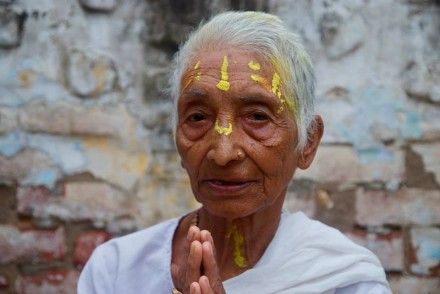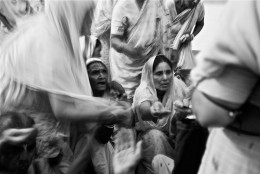Supriya Sobti explores the daily battles of India’s abandoned widows as they face restrictions on inheritance, remarriage and social welfare. This post and a related documentary first appeared on Al Jazeera.
Dying with dignity means different things in different cultures but for India’s widows, it means being cremated in accordance with traditional Hindu rituals.
I first encountered the widows of Vrindavan city in Utter Pradesh, during a trip nearly five years ago, visiting temples across India. Ironically, it was during my stay in this holy city that I began to question certain aspects of Hindu tradition. Why must a woman whose husband dies, lose her place in society? Why must she renounce her worldly desires and possessions? Most of all, why must she put herself through more pain, having just become a widow, and live a life of penance?
I was keen to explore the issue further and returned to Vrindavan last July to research a story on the city’s widows. The city attracts pilgrims who believe it is where the Hindu deity Krishna spent his childhood. It is also a magnet for India’s widows, seeking refuge after being ostracised and abandoned.
During my visit, I met widows living in privately rented accommodation and government-run care homes, but many more were facing greater hardships, surviving in dismal shacks or on the street. I was drawn to their stories. One after another, they spoke with the same underlying theme of abandonment and loneliness. Yet their strong will to survive shone through.
Many of the stories were distressing, ranging from how the widows had been exploited by their family members, to those who had been physically assaulted by their sons and daughters-in-law. Others had known little beyond a life of sorrow. They were child brides who lost their husbands at a tender age, only to be packed off to Vrindavan by their families before they could even make sense of what had happened to them.
Narotama Dasi, an octogenarian was married at the age of seven and widowed at nine. She came to Vrindavan from Nepal when she was 18. Today she lives at Radha Teela, a squat on the outskirts of Vrindavan that is home to 23 widows. “There was nothing here when I first arrived … it was an empty plot of land and we would sleep under this tree,” recalls Narotama.
She is now the squat’s oldest resident. “This tree is the only thing here that is older than me,” she quips. Unlike many who share, Narotama has her own small room, a tiny brick shed with no ventilation or electricity. But Narotama appears content.
I had spent a few hours at Radha Teela when Maya Dasi, a widow in her sixties, told me a shocking tale. The dead bodies of some of the city’s widows had been chopped into pieces, put into bags and thrown in the river. “Yes, it happens … it costs anywhere between $100 to $150 to buy wood for the cremation ceremony. How can we afford it?” asks Maya.
What disturbed me even more was how she told me the story with an air of acceptance.
“If we can’t collect enough money, then we buy whatever little wood we can, and cremate the body and whatever is left of it, we immerse in the river … we don’t have any other option,” Maya explains.
It was heartwarming to hear that even though these widows have so little, they still contribute whatever they can to buy wood for the cremation of another widow when she dies.
Critics like Mamta Sharma of the National Commission for Women blame government neglect for failing to tackle the issues facing India’s widows. Mamta believes if civic bodies and local governments followed the mandates set for them, such problems could be resolved. But it is a massive challenge with India now home to almost 42 million of the world’s 115 million poor widows, according to the United Nations.
I left Vrindavan to forget the warmth and stories of the widows at Radha Teela. A few weeks later, when I returned to film A Widow’s Penance, Dr Pathak, a philanthropist dedicated to helping India’s widows, agreed to visit Radha Teela with me.
After meeting the women and hearing their stories for himself, Dr Pathak gave them some life-changing news. He would adopt Radha Teela and take responsibility for the widows’ care. As well as providing them with a monthly stipend, clothes and medical treatment, his organisation, Sulabh International, will ensure that the widows’ last rites are performed with respect.
Maya smiled broadly upon learning that she would receive a proper cremation and die with dignity.
According to Hindu scriptures, cremation “releases an individual’s spiritual essence from its transitory physical body so it can be reborn”. Maya, and Vrindavan’s thousands of other widows, will surely be praying that the afterlife is free from the misery and suffering that has defined so much of their earthly lives.
Click here for “A Widow’s Penance“, a documentary about Vrindavan’s widows.
About the Author
Supriya Sobti is a freelance journalist and vice-chair of the LSE Alumni Association chapter in Mumbai.









